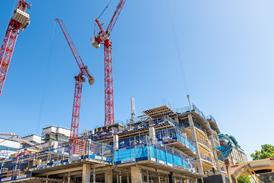- News

All the latest updates on building safety reformRegulations latest
- Focus
- Home
- News
- Focus
- Comment
- Events
- CPD
- Building the Future
- Jobs
- Data
- Subscribe
- Building Boardroom
Is the government’s Building Safety Regulator shake-up enough to fix the delays?
By Tom Lowe2025-07-08T06:00:00

The government has promised to speed up approvals for high-rise residential schemes which have been languishing for up to a year in the new building safety regime. The industry’s reponse so far has been muted. With patience running out and costs mounting, Tom Lowe speaks to the people caught up ...
UKREiiF this year was busier than ever. More than 16,000 professionals from across the construction sector filled a small section of Leeds over three sunny days in May to network, booze and discuss the latest goings-on in construction.
Most of the many dozens of events held during the conference were predictably policy-focused and well-behaved. But there was one particular panel discussion which stood out.
It was obvious, just walking up to the Places for Life tent on the Wednesday morning, that something significant was happening. A crowd of attendees stood outside, craning their necks to get a view of the stage.
Inside, it was at full capacity. The event, sponsored by regional contractor Caddick and build-to-rent developer Moda, was a discussion on the ongoing delays to high-rise residential schemes which have been caused by the new building safety regime.
…
Already registered? Login here
To continue enjoying Building.co.uk, sign up for free guest access
Existing subscriber? LOGIN
Stay at the forefront of thought leadership with news and analysis from award-winning journalists. Enjoy company features, CEO interviews, architectural reviews, technical project know-how and the latest innovations.
- Limited access to building.co.uk
- Breaking industry news as it happens
- Breaking, daily and weekly e-newsletters
Get your free guest access SIGN UP TODAY

Subscribe now for unlimited access
Subscribe to Building today and you will benefit from:
- Unlimited access to all stories including expert analysis and comment from industry leaders
- Our league tables, cost models and economics data
- Our online archive of over 10,000 articles
- Building magazine digital editions
- Building magazine print editions
- Printed/digital supplements
Subscribe now for unlimited access.
View our subscription options and join our community


















